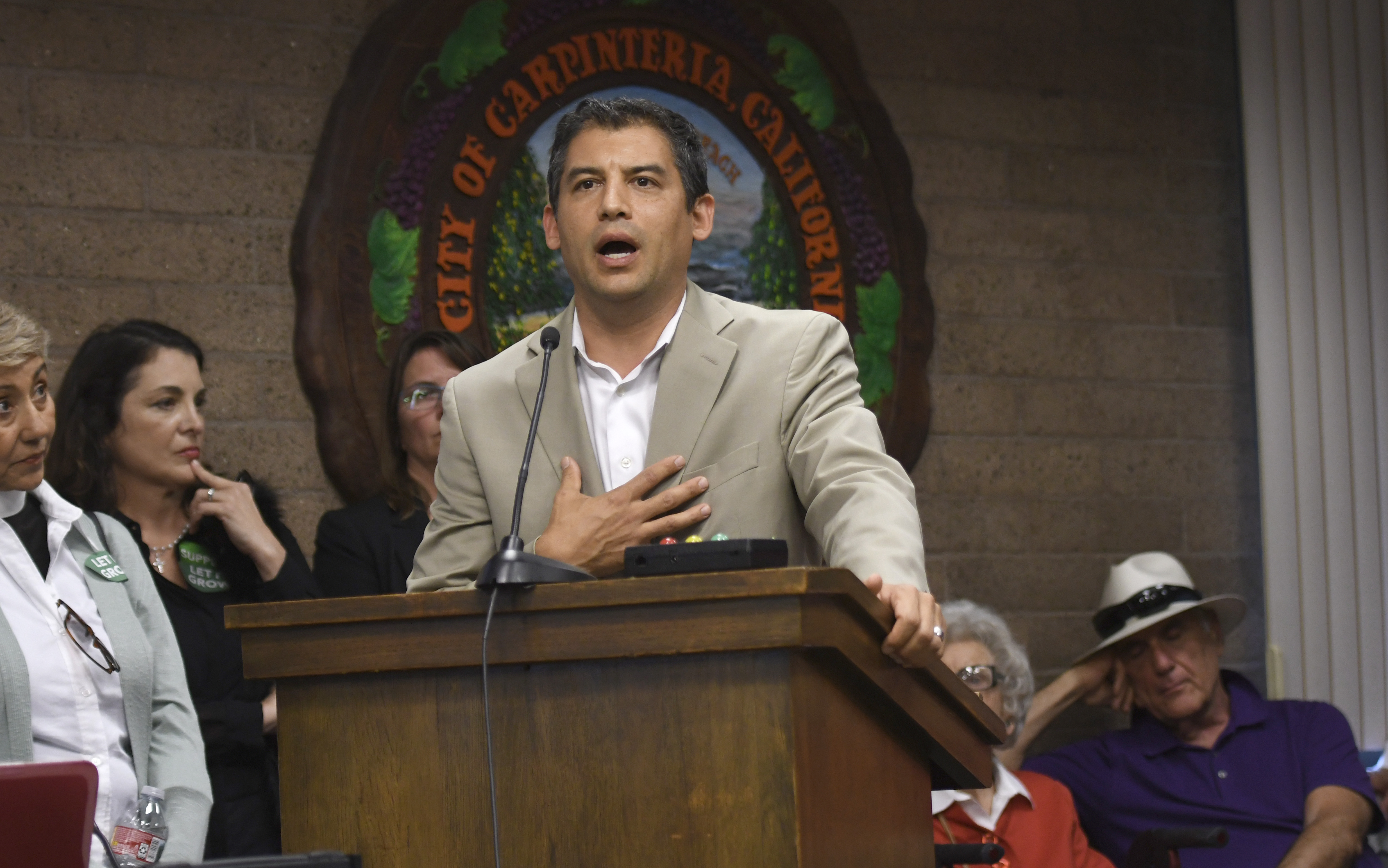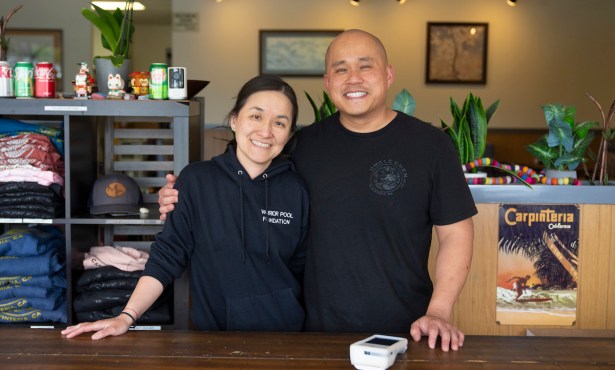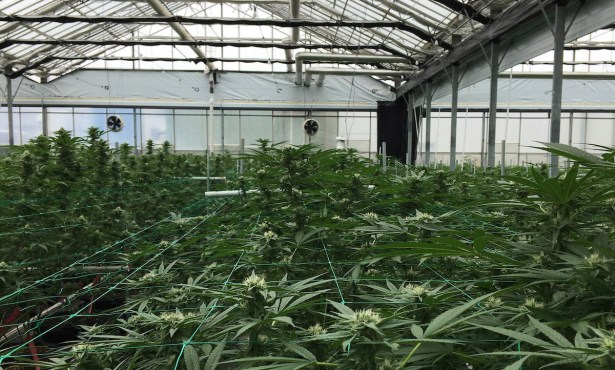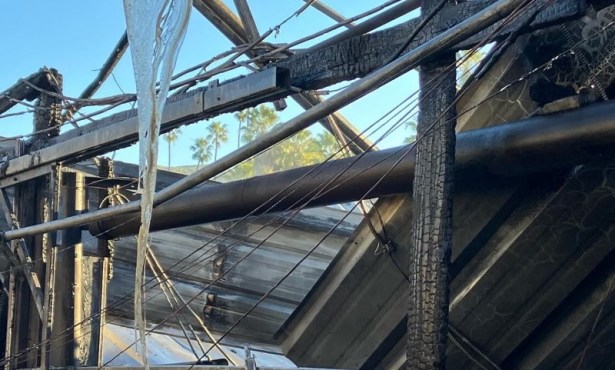Carpinteria City Council Throws Down Over Cannabis
County Supervisor Das Williams Defends Reputation at Marathon Vent Fest

It wasn’t so much what was said or even the intensity with which it was said. Instead, it was the astonishing number of people who jammed shoulder to shoulder into the Carpinteria City Council chambers Monday night to speak their minds — pro and con — about the burgeoning cannabis industry that’s taken over the greenhouses of the Carpinteria Valley.
More than 200 people showed up — a record for Carpinteria — spilling into overflow rooms and choking the aisles. More than 60 spoke. Two former city councilmembers found themselves forced to share just one seat. One councilmember lamented afterward how the crowded aisles precluded a much-needed restroom visit.
At issue was a resolution expressing the City of Carpinteria’s displeasure with the County of Santa Barbara for allowing so much cannabis to be cultivated in such close proximity to two high schools — one public and one private — and within smelling distance of so many Carpinteria residents. The resolution — which carries no binding weight — castigated the county for its “permissive” regulatory environment that allowed for “an overconcentration” of commercial cannabis in Carpinteria. It complained about lack of enforcement and that the county supervisors had “largely ignored” repeated concerns expressed by the Carpinteria City Council over malodors and other issues for the past two years.
County Supervisor Das Williams — who lives in Carpinteria — was as conspicuous by his presence Monday night as he was by his absence two weeks ago when the Carpinteria Council held the first of two public information sessions on cannabis. Williams chose not to attend the first meeting because, as he explained at the time, he didn’t wish to become “derailed” from issues like climate change that prompted him to run for supervisor three years ago. Since then, however, Williams’s cozy social relationships with cannabis-industry lobbyists and growers were highlighted in a lengthy Los Angeles Times article about Santa Barbara’s blooming cannabis industry.
“It stings to have my integrity impugned because I socialized with some marijuana growers in this city,” declared Williams, who said it’s his job to meet with all his constituents and insisted he’d met with far more critics of cannabis cultivation than its supporters. Out of those meetings, he said, he got ideas on how to better safeguard Carpinteria residents from some of the new industry’s unintended consequences.
Carpinteria, he noted, is the only place in Santa Barbara to have an acreage cap on cannabis cultivation: 186. Carpinteria, he claimed, is the only community to be protected by odor-control requirements. As a result, he said, problems with the smell have “gotten better and better and better.”
Williams’s remarks did little, however, to change the mind of Ann Louise Bardach, a journalist and outspoken critic of Williams and the county’s cannabis industry. “Many of us don’t feel we have a supervisor we can talk to,” Bardach said. “Our 1st District supervisor has one primary constituency, and that is the pot growers.” Bardach concluded her remarks by calling for “an immediate moratorium and an investigation into how the cannabis ordinance was written.”
What set Monday night’s testimonials apart was the strong showing by growers and members of the industry, many of whom have kept low profiles for fear of being discharged by their federally regulated banks. Numerous members of the Van Wingerden and Brand families showed and testified on behalf of a crop they embraced only after international trade decimated their cut-flower business. In contrast to what they used to grow, they argued, cannabis used no pesticides, less energy, and less water. They needed fewer trucks and could pay their workers better. And when it came to area nonprofits, no other donors, they pointed out, were as consistent or as generous.

They disputed allegations that cannabis fumes caused respiratory ailments, asthma, and headaches, as their critics charge. They said they grow only female plants, which have no pollen. To charges that cannabis was ruining property values, Ivan Van Wingerden retorted that property values in Carpinteria increased by 11.7 percent in 2018, five times higher than the state average. Crime in Carpinteria, he claimed, was half the state average, while violent crime in Ventura, where cannabis cultivation is not allowed, is 24 percent higher.
For the councilmembers, the conclusion was foregone. The only suspense was whether they’d call for a moratorium. They did not. Instead, they called on the county supervisors to adopt new regulations that require odor-control systems on all greenhouses as soon as possible rather than waiting until the operator has an approved project. Currently, 14 of the 26 greenhouse operations in Carpinteria have odor-control systems installed. If the process unwinds as Williams indicates, it could be another year before installation of such equipment is mandated. But under a new law proposed by Governor Gavin Newsom, that deadline could be extended to five years.
The resolution will be sent to the county supervisors, the air pollution control district, the California Coastal Commission, and to every city council in the county.




You must be logged in to post a comment.